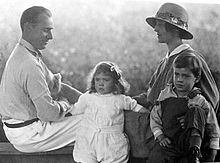- Charles Cary Rumsey
-
Charles Cary Rumsey 
Charles, Mary Averell, Mary, Charles Jr., c.1919Born August 29, 1879
Buffalo, New York, United StatesDied September 21, 1922 (aged 43)
Floral Park, New York, United StatesCause of death Automobile accident Resting place Forest Lawn Cemetery, Buffalo Residence Wheatley Hills, Long Island, New York Education Harvard University, Boston Art School, École des Beaux-Arts Occupation Sculptor, Polo player Known for Figurative art Political party Democratic Religion Episcopalian Spouse Mary Harriman Children 1) Charles Cary Harriman (b.1911)
2) Mary Averell (b. 1913)
3) Bronson Harriman (1917–1939)Parents Laurence Dana Rumsey & Jennie Cary Relatives Brother: Laurence Dana Rumsey, Jr.
Brother-in-law: W. Averell HarrimanCharles Cary Rumsey (August 29, 1879 – September 21, 1922) was an American sculptor and an eight goal polo player.
Born in Buffalo, New York, Charles Rumsey was the son of Laurence Dana Rumsey, a successful local businessman. His mother, Jennie Cary Rumsey, was the sister of sculptor, Seward Cary. Young Charles learned to play polo at a young age from his uncle and friend, Devereux Millburn.
Education and art career
Charles Rumsey graduated Harvard University then studied art at the Boston Art School before going to Paris, France to study at the École des Beaux-Arts. He worked mainly in bronze and had a fondness for equine figures that saw him create statues of the Thoroughbred horses Hamburg and Burgomaster for Harry Payne Whitney, Good and Plenty for Thomas Hitchcock, and World Champion trotter Nancy Hanks[1] for John E. Madden. Among Rumsey's other works, he did a statue of Francisco Pizarro erected in Trujillo, Spain, the Brownsville War Memorial in Brownsville, Brooklyn, the "Three Graces Fountain" in Mirror Lake at Forest Lawn Cemetery, Buffalo, and the controversial figure of a nude woman called "The Pagan."[2] Perhaps his most celebrated work is the 1916 frieze on the Manhattan Bridge in New York City titled "Buffalo Hunt."
During the first decade of the 20th century, Charles Rumsey maintained an art studio on 59th Street in New York City when he met Mary Harriman, the daughter of railway magnate E. H. Harriman. They both shared a love of horses and had first met at the Meadow Brook Steeplechase Association races on Long Island. They married in 1910 and maintained a home in Brookville, New York on Long Island where they raised three children.
During World War I, Charles Rumsey served as a Captain with Headquarters Troop, 77th Infantry Division and Fortieth Engineers, United States Army Corps of Engineers. His brother, Laurence Dana Rumsey, Jr. (1885–1967), was a pilot in the War with the famous Lafayette Escadrille and Lafayette Flying Corps.
On September 21, 1922, Charles Rumsey was a passenger in an automobile that crashed into a stone bridge abutment on the Jericho Turnpike near Floral Park on Long Island. He was thrown from the vehicle and died minutes later from his injuries.[3]
References
- ^ "Nancy Hanks", The Lewiston Daily Sun, October 1, 1915
- ^ "Nude Figure Wins After Court Move", New York Times, March 22, 1921
- ^ "Charles C. Rumsey Dies in Auto Crash on Jericho Turnpike", New York Times, September 22, 1922
External links
Categories:- 1879 births
- 1922 deaths
- Road accident deaths in New York
- Harvard University alumni
- American military personnel of World War II
- American sculptors
- People from Buffalo, New York
Wikimedia Foundation. 2010.

